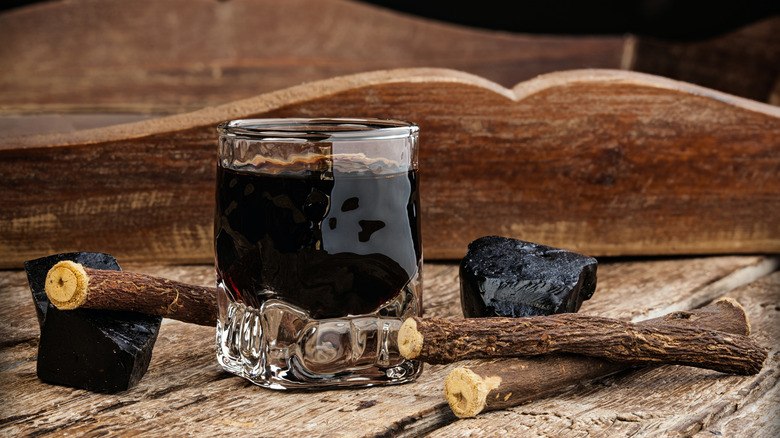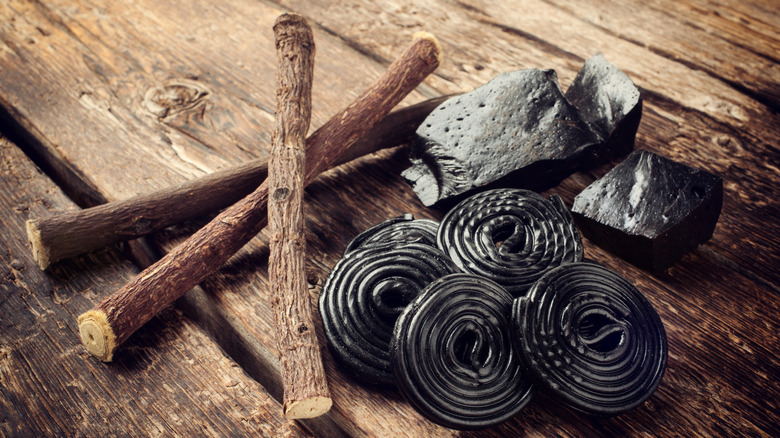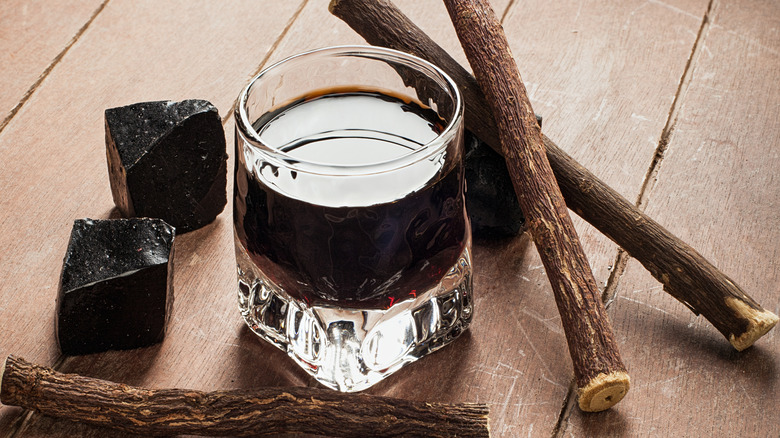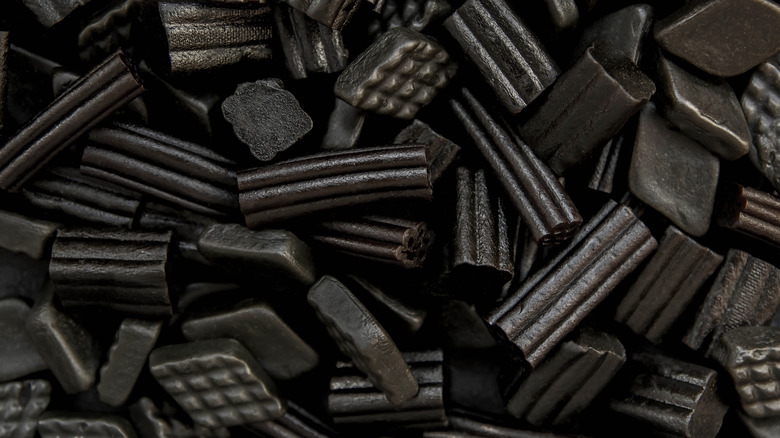What Makes Licorice Liqueur So Unique?
Licorice (Glycyrrhiza glabra) is an acquired flavor only some get along with. Licorice — real licorice, that is — is a medicinal sweet root used throughout history to treat minor and severe illnesses. Mount Sani says that root is native to both Europe and Asia and can be bought whole, dried, and powdered. The root can be mixed into medicine, teas, syrups, and even liquor, but its flavor might come as a bit of a shock to the casual drinker.
It is common for people to flashback to drinks like ouzo or raki, which are popular in and around the Mediterranean for their pungent "licorice" aroma, when thinking of licorice booze. The funny part is that these liqueurs aren't actually flavored using licorice root but instead with aniseed or star anise, which is very similar in that sweet-dark flavor and is often combined with other spices for a complex drinking experience (via Gramercy Wine). Though many of our so-called "licorice" liqueurs are simply mimicking the taste of the powerful root, there is one drink that actually does use the licorice plant, real licorice liqueur.
How it's made
If you aren't a huge fan of black licorice, licorice liqueur is not for you. According to La Cucina Italiana, this dark, syrupy licorice liqueur is treated much like an aperitif or digestif and can be made at home as easily as classic limoncello! Quality licorice is absolutely key to a successful licorice liqueur, and you must either use licorice powder (hard to come by) or pure licorice drops but not the physical roots themselves, which have way too much power. This licorice is then added to any 95% alcohol of your choice and added with other herbs for several days to be sure the drink has properties steeped.
Another way to make this liquor is using Bottega di Calabria's method. The site recommends melting pure licorice chunks with water and sugar in a saucepan on the stove and cooking down the syrup for three hours. After making your own homemade licorice syrup, add the cooled liquid to your high-proof booze with some vanillin (the chemical extract of a vanilla bean) and let it age for a month or more for the best possible flavor.
What licorice liqueur tastes like
Licorice liqueur is not like anise-flavored booze such as ouzo in the sense that this drink isn't clear in color. According to the Cocktail Society, licorice liqueur is extremely dark and thick and, like other herbal-infused liqueurs, is not meant to be drunk in one shot but instead must be sipped on. Licorice liqueur often uses a blend of other botanicals, which gives the beverage a woody-spicy butter-sweet note that not everyone finds wholly agreeable.
Delighted Cooking says that licorice liqueur is sometimes mixed into a cocktail as a boozy syrup and is sometimes blended with a heady mix of wormwood along with the licorice root, making it hallucinogenic (think absinthe). Arthur Cantina states that unless individuals have experienced the true power of licorice root before, they are heartily underprepared for the intense earthy spice it carries, which makes star anise and anise seed flavors seem positively meek in comparison.
More about licorice liqueur
If you are curious about this intoxicatingly powerful liquor, despite its ability to pack a heavy punch, you'll be following in the footsteps of an ancient and long line of licorice lovers. The National Center for Complementary Integrative Health website says that throughout recorded history in parts of Europe, Asia, and the Middle East, licorice root has been an integral aspect of candy, tobacco, and beverage production. This was because of the medicinal qualities the root possessed, such as slowing the progression of diseases, and it was widely used by ancient Assyrian, Egyptian, Chinese, and Indian healers to aid digestion. Today, licorice liqueur is used in mixed drinks but also drunk as a digestif after a hearty dinner because licorice is known as a natural diuretic and anti-inflammatory substance (via Your Guardian Chef).
According to Atlas Obscura, true licorice liquor is only popular in a few select regions of the modern world, including southern Europe, where people indulge in anise-flavored aperitif quite often, but this licorice drink is also quite well-beloved in the Netherlands. The Dutch people call the licorice liquor a "Drop Shot" and it is manufactured and sold in two ways: the basic bitter-sweet herbal beverage or the "double black" which has an unmistakable salty kick. Licorice liquor is a booze for the adventurous spirit and strong stomach, but ultimately, it is a European classic that many still enjoy!



